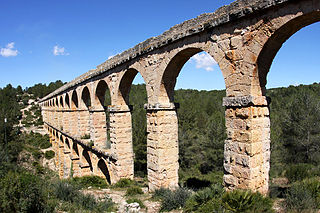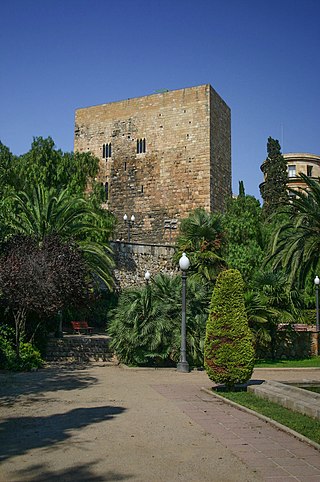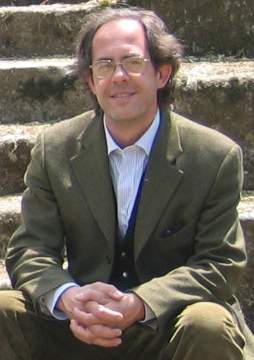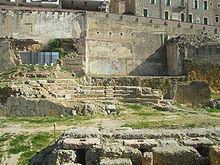
Tarragona is a port city located in northeast Spain on the Costa Daurada by the Mediterranean Sea. Founded before the fifth century BC, it is the capital of the Province of Tarragona, and part of Tarragonès and Catalonia. Geographically, it is bordered on the north by the Province of Barcelona and the Province of Lleida. The city has a population of 136,150 (2021).

Tarragona is a province of eastern Spain, in the southern part of the autonomous community of Catalonia. It is bordered by the provinces of Castellón, Teruel, Zaragoza, Lérida and Barcelona and by the Mediterranean Sea.

Tarraco is the ancient name of the current city of Tarragona. It was the oldest Roman settlement on the Iberian Peninsula. It became the capital of the Roman province of Hispania Citerior during the period of the Roman Republic, and of Hispania Tarraconensis following the latter's creation during the Roman Empire.

The Cessetani were an ancient Iberian (Pre-Roman) people of the Iberian peninsula. They are believed to have spoken the Iberian language. Their territory extended along the coast between the Coll de Balaguer and the Garraf Massif and was limited in the west by the Prades Mountains.

Legio VII Gemina was a legion of the Imperial Roman army. It was raised in AD 68 in Hispania by the general Galba to take part in his rebellion against the emperor Nero. "Gemina" means the legion was dedicated to the legendary twin founders of Rome, Romulus and Remus, who were suckled by a she-wolf. The legion was deployed in the city called Legio in AD 74 and remained in Hispania to the end of the 4th century.

The Roman circus was a large open-air venue used for public events in the ancient Roman Empire. The circuses were similar to the ancient Greek hippodromes, although circuses served varying purposes and differed in design and construction. Along with theatres, amphitheatres, and the similar but much smaller stadiums, circuses were one of the main entertainment sites of the time. Circuses were venues for chariot races, horse races, gladiatorial combat, and performances that commemorated important events of the Empire were performed there.

Tarragona Amphitheatre is a Roman amphitheatre in the city of Tarraco, now Tarragona, in the Catalonia region of north-east Spain. It was built in the 2nd century AD, sited close to the forum of this provincial capital.

The Arc de Berà is a triumphal arch some 20 km north-east of the city of Tarragona, Catalonia, Spain, close to Roda de Berà. This monument is part of the Archaeological Ensemble of Tarraco, which was added to the UNESCO's list of World Heritage Sites in 2000. It stands on the line of what was the Via Augusta, now the N-340 road.

The Ferreres Aqueduct, also known as the Pont del Diable, is an ancient bridge, part of the Roman aqueduct built to supply water to the ancient city of Tarraco, today Tarragona in Catalonia, Spain. The bridge is located 4 kilometers north of the city and it is part of the Archaeological Ensemble of Tarraco.
The Vegueria of Tarragona was a historical territorial entity of Catalonia that agglutinated the counties of Tarragona. In all the moments of validity of this territorial division, the capital of the Vegueria of Tarragona has been the city of Tarragona. This city has been the genesis of all the territory.

The provincial forum of Tarraco is a Roman archaeological site in Tarragona, Catalonia, Spain, encompassing an area of 18 ha. Together with other Roman remains in the city it makes the Archaeological Ensemble of Tarraco, which was listed in the UNESCO World Heritage Sites in 2000.

Torre dels Escipions is a funerary tower built by the Romans on the outskirts of Tarraco, ancient Roman city that corresponds to the present city of Tarragona. The Torre dels Escipions is one of the elements of the Archaeological Ensemble of Tarraco, declared a World Heritage Site by UNESCO, the tower being identified with the code 875-010.

The Romanization of Hispania is the process by which Roman or Latin culture was introduced into the Iberian Peninsula during the period of Roman rule.

The Roman quarry of El Mèdol was first excavated during the period of the Roman Republic and the Roman Empire.

The colonial forum of Tarraco is an ancient Roman archaeological site located in the modern city of Tarragona in Catalonia, Spain.
Roman Forum of Tarragona may refer to:

Augurius of Tarragona or Saint Augurius was a Christian Hispano-Roman clergyman. It is also cited as Augurinus. Exerting the office of deacon was martyred along with bishop Fructuosus and deacon Eulogius. He died burned alive in the amphitheater of Tarraco during the persecution decreed by the Roman emperors Valerian and Galerius. Possibly were the first martyrs of which there is some sort of documentation in the history of Christianity in Spain.

Xavier Dupré i Raventós was a Spanish archaeologist and historian of classical antiquity. He was the first provincial archaeologist appointed by the archaeological division of the Generalitat de Catalunya in Tarragona. He was also director of Taller–Escola d’Arqueologia de Tarragona (TED’A), director of excavations of the Roman city of Tusculum and deputy director of the Escuela Española de Historia y Arqueología in Rome.
The Battle of Tarraco was fought between the Vandals and the Western Roman Empire at Tarraco, Hispania Tarraconensis in 422. Campaigning in eastern Hispania, the Vandal king Gunderic had earlier defeated the Suebi. He met the Roman commander Flavius Castinus at Tarraco, modern day Tarragona. With the desertion of their Visigothic allies, the Romans were utterly defeated, making the Vandals the undisputed masters of Hispania. After the death of Gunderic, his brother Genseric led the Vandals to North Africa, where they founded a powerful kingdom.

The SEAT Tarraco is a mid-size crossover SUV manufactured by Spanish automaker SEAT. It is the flagship SUV of the Spanish car maker above the SEAT Arona and the SEAT Ateca, optionally available with seven seats. It is based on the Volkswagen Group's MQB-A2 platform, while closely related to the Volkswagen Tiguan Allspace and the Škoda Kodiaq.


















